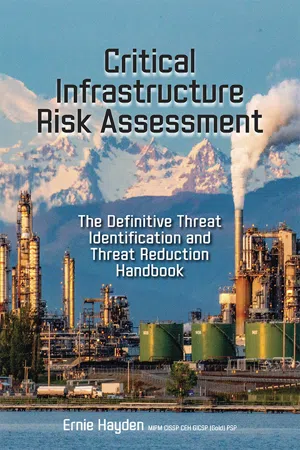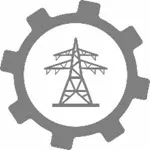
eBook - ePub
Critical Infrastructure Risk Assessment
The Definitive Threat Identification and Threat Reduction Handbook
- 363 pages
- English
- ePUB (mobile friendly)
- Available on iOS & Android
eBook - ePub
Critical Infrastructure Risk Assessment
The Definitive Threat Identification and Threat Reduction Handbook
About this book
As a manager or engineer have you ever been assigned a task to perform a risk assessment of one of your facilities or plant systems? What if you are an insurance inspector or corporate auditor? Do you know how to prepare yourself for the inspection, decided what to look for, and how to write your report?
This is a handbook for junior and senior personnel alike on what constitutes critical infrastructure and risk and offers guides to the risk assessor on preparation, performance, and documentation of a risk assessment of a complex facility. This is a definite "must read" for consultants, plant managers, corporate risk managers, junior and senior engineers, and university students before they jump into their first technical assignment.
Frequently asked questions
Yes, you can cancel anytime from the Subscription tab in your account settings on the Perlego website. Your subscription will stay active until the end of your current billing period. Learn how to cancel your subscription.
No, books cannot be downloaded as external files, such as PDFs, for use outside of Perlego. However, you can download books within the Perlego app for offline reading on mobile or tablet. Learn more here.
Perlego offers two plans: Essential and Complete
- Essential is ideal for learners and professionals who enjoy exploring a wide range of subjects. Access the Essential Library with 800,000+ trusted titles and best-sellers across business, personal growth, and the humanities. Includes unlimited reading time and Standard Read Aloud voice.
- Complete: Perfect for advanced learners and researchers needing full, unrestricted access. Unlock 1.4M+ books across hundreds of subjects, including academic and specialized titles. The Complete Plan also includes advanced features like Premium Read Aloud and Research Assistant.
We are an online textbook subscription service, where you can get access to an entire online library for less than the price of a single book per month. With over 1 million books across 1000+ topics, we’ve got you covered! Learn more here.
Look out for the read-aloud symbol on your next book to see if you can listen to it. The read-aloud tool reads text aloud for you, highlighting the text as it is being read. You can pause it, speed it up and slow it down. Learn more here.
Yes! You can use the Perlego app on both iOS or Android devices to read anytime, anywhere — even offline. Perfect for commutes or when you’re on the go.
Please note we cannot support devices running on iOS 13 and Android 7 or earlier. Learn more about using the app.
Please note we cannot support devices running on iOS 13 and Android 7 or earlier. Learn more about using the app.
Yes, you can access Critical Infrastructure Risk Assessment by Ernie Hayden, MIPM, CISSP, CEH, GICSP(Gold), PSP in PDF and/or ePUB format, as well as other popular books in Business & Infrastructure. We have over one million books available in our catalogue for you to explore.
Information

PART I
FOUNDATIONS
Before you can begin to conduct a risk assessment you need to understand a few fundamentals. This section helps you get prepared before you pick up your pen and camera to walk down the site.
Part I includes essential information on the following:
- What constitutes Critical Infrastructure and how is it defined in the US and internationally?
- What is Risk? What are the elements that make up this concept?
- What is a Risk Assessment? What are the different types of risk assessments and their constituent parts?
You should find this an interesting read which will offer the basic information necessary to jump into the risk assessment phase.

Chapter 1
Just What is
Critical Infrastructure?
Infrastructure sector is all about building assets for the country. It is part of nation building.1
- Gautam Adani
- Gautam Adani
This chapter brings you the fundamentals of what constitutes critical infrastructure and the associated government policies from the US and internationally. Since this book will discuss approaches and techniques when performing risk assessments of critical infrastructure, it is important for the executive and the assessment team to understand what critical infrastructure constitutes as a concept, and the history of it becoming a policy idea for government focus. Then, with this knowledge, the assessment process can be more holistic and complete with better understanding of a) what is critical infrastructure, b) what sectors does my company/institution rely upon, and c) how are the sectors interdependent and what is their effect on my organization’s performance and production?
1.1 What is Critical Infrastructure?
So, just what is critical infrastructure?
We are surrounded by it. We use it every day. It keeps our factories running, schools operating, and governments governing.
Infrastructure is very important for the function of a nation as well as an industrial sector.
One of my favorite quotes about infrastructure is from an article in The Atlantic where the author, Ian Bogost observed2:
Infrastructure is everything you don’t think about. The roads you drive on. The rigs and refineries that turn fossil fuel into the gas that makes your car go. The electricity that powers the streetlights and lamps that guide your way. All these technologies vanish into the oblivion of normalcy.
To give you a sense of how large this challenge is, the 2003 National Strategy for the Physical Protection of Critical Infrastructure and Key Assets offered a list of the different sectors and the scope of every way an attacker can penetrate your perimeter digitally and physically. Such a concept of the ways to break into an organization is often referred to as the attack surface.
This updated list is provided in the table below and, upon study, can be not only impressive but overwhelming to national policy makers and defenders.3
Table 1.1 Critical Infrastructure Attack Surface
| Agriculture & Food |
|
| Banking & Finance |
|
| Chemical Industry & Hazardous Materials |
|
| Commercial Assets |
|
| Dams |
|
| Defense Industrial Base |
|
| Emergency Services |
|
| Energy |
|
| Government Facilities |
|
| Natural Monuments & Icons |
|
| Nuclear Power Plants |
|
| Postal & Shipping |
|
| Public Health |
|
| Telecommunications |
|
| Transportation |
|
| Water & Wastewater |
|
The United States has been a leader in defining critical infrastructure, what it constitutes, and protection policies. However, this is not just an American problem. A CIPedia15 article identified 40 countries that have put forth a definition or at least a list of what constitutes critical national infrastructure. I will provide an in-depth review of the United States and a few other countries and their approach to critical infrastructure definition and protection policy in the discussion which follows.
1.2 Critical Infrastructure Conceptual Development — United States
Infrastructure can be defined as:
Basic facilities, services and installations needed for the functioning of a community or society.
One of the earliest policy reviews identified in my research is from the United States Congressional Budget Office (CBO). The report, Public Works Infrastructure: Policy Considerations for the 1980’s, was initiated at the request of the Senate Committee on the Budget in order to “...assess the needs of seven infrastructure systems and the costs of meeting those needs.” (Bodde, page iii).
In this document, the concept of “critical” infrastructure is not discussed; however, the report identifies the following infrastructure verticals considered for this review.
- Highways ...
Table of contents
- Cover
- Title page
- COPYRIGHT ©2020, Ernie Hayden
- WHAT YOUR COLLEAGUES ARE SAYING ABOUT CRITICAL INFRASTRUCTURE RISK ASSESSMENT
- DEDICATION AND ACKNOWLEDGEMENTS
- Foreword by Kirk Bailey
- Foreword by Peter Gregory
- CONTENTS
- Introduction
- PART I FOUNDATIONS
- PART II HANDBOOK
- APPENDIX A EXAMPLE RISK ASSESSMENT REPORT
- INDEX
- ABOUT THE AUTHOR